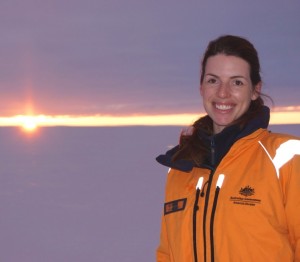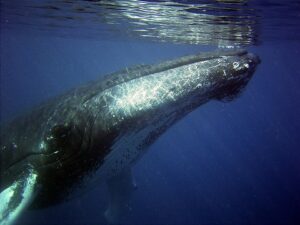Studies into the interactions between migrating humpback whales and marine vessels such as passenger ferries, recreational boats and cargo ships off the South East Queensland coast has strengthened the bonds between research, government, and stakeholders in a proactive approach to understand the behaviour of whales in Moreton Bay.
Professor Susan Bengtson Nash, from Griffith University’s Centre for Planetary Health and Food Security, is leading the three-year Australian Research Council Linkage project ‘Life in The Shipping Lane’, which was granted $323,388 in 2022.

Associate Professor Susan Bengtson Nash, Centre of Planetary Health and Food Security
Working closely with the Port of Brisbane, the project extends an existing four-year partnership to understand humpback whale abundance and distribution in Moreton Bay, a first step and proactive response to the Federal Government’s National Strategy for Reducing Vessel Strike on Cetaceans and other Marine Megafauna.
The project has been developed in collaboration with traditional owners, not-for-profit organisations, and local industry. Previously, there was very little data to assess the behaviour of whales in the region and the project is expected to identify potential mitigation measures for consideration.
There have not to date been any reported whale ship strikes within the Port of Brisbane’s shipping channel. Previously, there was very little data to assess the behaviour of whales in the wider Moreton Bay area and the Port of Brisbane considered it important to understand any potential risks to enable informed risk-based decision making.
Lead researcher Professor Susan Bengtson Nash said the findings would help fill knowledge gaps surrounding the populations’ seasonal distribution and habitat use in coastal waters which in turn would inform management of human-whale interactions in the region.
“The Moreton Bay region is characterised by rapid coastal and maritime development, as well as a growing humpback whale population,” Professor Bengtson Nash said.
“These findings present a local environmental management challenge but also an opportunity for the sustainable use of this rapidly developing region.
“These findings will help build our knowledge about how whales use the Bay, informing future planning and supporting a safer Moreton Bay for all.”
Port of Brisbane CEO, Neil Stephens, said the Port saw great value in helping fund the research to enable all parties to better understand whale behaviour at a local level.
“Moreton Bay is widely enjoyed by the community and the northern part of the Bay incorporates the Port’s shipping channels, which are critical to servicing South East Queensland’s growing population. The research to date has shown that parts of Moreton Bay are important areas for migrating whales which is valuable information to help better understand whale behaviour in the local area,” Mr Stephens said.
The research team have already made strong headway with their research, recently publishing findings of five years’ worth of strategic surveys in Frontiers in Marine Science that uncovered Moreton Bay as an important resting area for migrating humpback whales.
This study found:
- on average, 42% of the individuals observed on the southern leg of the migration entered the bay;
- 77% of pods entering the bay had accompanying calves;
- And 48% of these pods were found to be resting or ‘logging’ (a behaviour associated with nursing).
Dr Juliana Castrillon, who was employed on the consultancy, said studies such as this were vital to highlight the importance of resting stopovers in general throughout the whales’ annual migration.
“There is also a need to determine other stopovers along migration and consider risk mitigation measures to protect these individuals within these areas,” she said.
The research team PhD candidate Raphael Maynaud, who is supervised by Professor Bengston Nash, detailed the development of spatial models to predict where humpback whales were likely to be found within Moreton Bay, and to what degree they overlapped with commercial shipping traffic.
“We’ve identified areas within the Moreton Bay region where ships and whales may potentially interact with each other and this information can then help promote the safety of humpback whales,” Maynaud said.
This research, published in Marine Policy, monitored the movements and patterns of humpback whales within Moreton Bay over five years.
Professor Bengston Nash said this long-term research project and the resulting findings would also bring focus to the need for identifying similar resting stopover sites of these extreme migratory populations across their species range.

